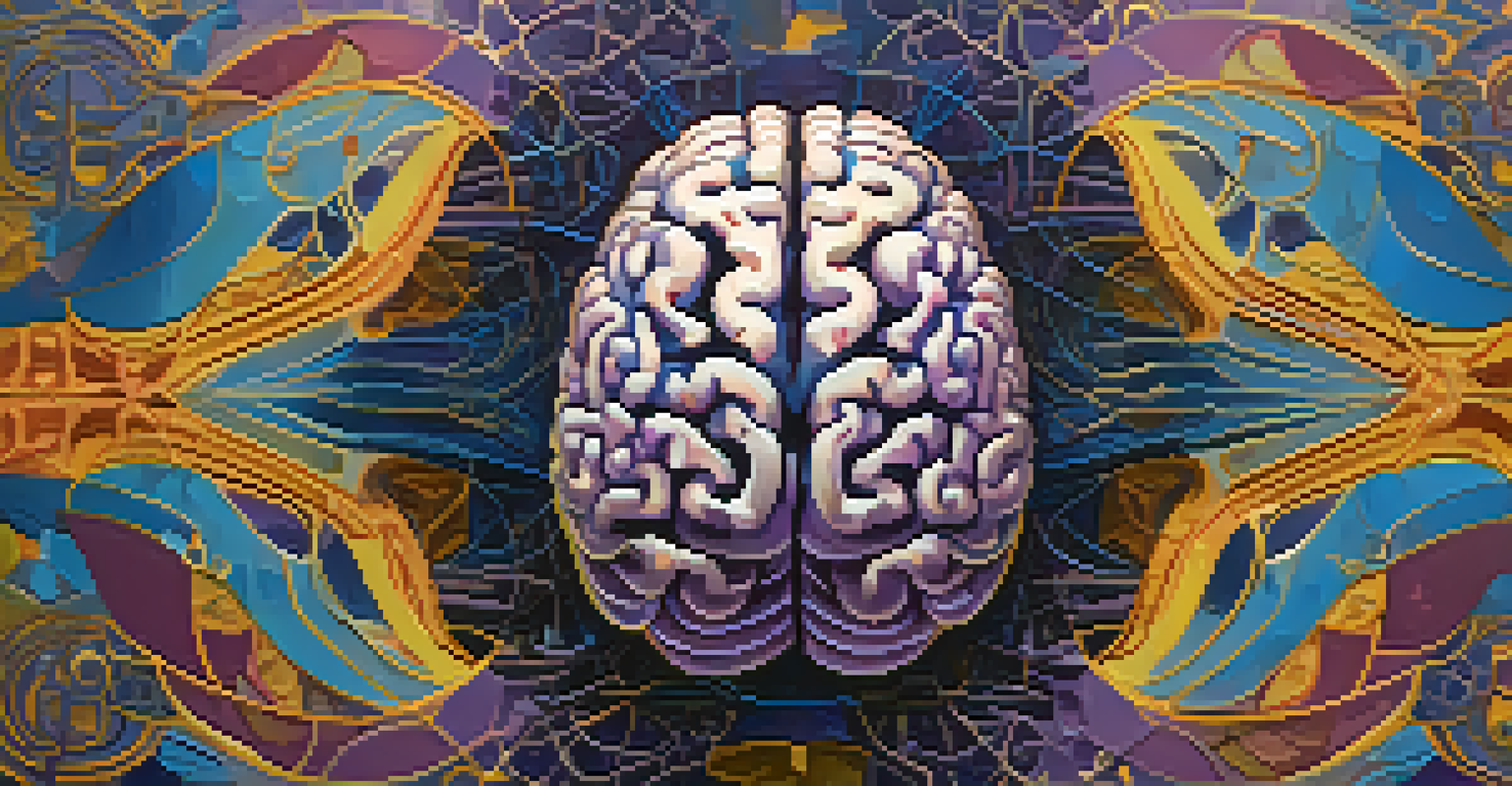The Science Behind Entheogens and Altered States of Mind

What Are Entheogens and Their Historical Use?
Entheogens are substances that can induce altered states of consciousness, often used in spiritual or religious contexts. Historically, cultures around the globe have turned to these natural compounds, from ancient Indigenous tribes using peyote to the rituals of South American shamans with ayahuasca. These practices often aimed to connect users with the divine or to explore the depths of the human mind.
The use of entheogens is a journey into the depths of the human experience, revealing insights that are often obscured in our everyday lives.
The term 'entheogen' itself comes from Greek, meaning 'generating the divine within.' This highlights the profound experiences many users report, often describing feelings of unity, transcendence, and deep personal insight. It's intriguing how these substances have been a part of humanity's spiritual journey for centuries, serving as tools for exploration and understanding.
In modern contexts, the renewed interest in entheogens reflects a broader search for meaning and understanding in an increasingly complex world. As people seek alternative methods for personal growth and healing, the historical significance of these substances reminds us that the quest for knowledge and connection is timeless.
The Chemistry of Altered States: How Entheogens Work
At the core of how entheogens function are their chemical compounds, which often interact with neurotransmitters in the brain. For instance, psilocybin, the active ingredient in magic mushrooms, is converted into psilocin, which closely resembles serotonin. This interaction can lead to changes in perception, mood, and cognitive processes, inducing those sought-after altered states.

Furthermore, entheogens can amplify neural connectivity, allowing different parts of the brain to communicate more freely. This can lead to experiences of heightened creativity, emotional release, and even feelings of interconnectedness with the universe. Imagine your brain as a symphony orchestra; these substances can encourage the musicians to play together in unexpected ways, creating a unique and beautiful sound.
Entheogens and Spiritual Healing
Entheogens have been historically used across cultures as tools for spiritual connection and personal exploration.
However, the effects can vary widely based on dosage, individual biology, and the setting in which the substance is consumed. Understanding this chemistry not only demystifies the experience but also underscores the importance of responsible use, as the right environment can significantly enhance or detract from the journey.
The Psychological Effects of Entheogens: A Closer Look
Users of entheogens often report profound psychological effects, ranging from therapeutic insights to transformative experiences. These substances can help individuals confront deep-seated fears, unresolved trauma, or even existential questions. For many, a single session can lead to shifts in perspective that would take years of traditional therapy to achieve.
Psychedelics can help us to break down the barriers of our ego and allow us to reconnect with the world in a profound way.
Interestingly, studies have shown that entheogens can promote neuroplasticity, the brain's ability to reorganize itself by forming new neural connections. This means that after an entheogenic experience, individuals might find it easier to adopt healthier behaviors or let go of negative patterns. Picture your mind as a garden; these substances can help clear out the weeds, allowing new, vibrant growth.
Nevertheless, not every experience is positive. Some individuals may encounter anxiety or distress, commonly referred to as a ‘bad trip’. This underscores the importance of set and setting—having the right mindset and environment can greatly influence the outcomes of the experience.
Entheogens in Modern Therapeutics: A New Frontier
Recently, there's been a surge of interest in the potential therapeutic benefits of entheogens, particularly for mental health conditions like depression, PTSD, and anxiety. Clinical trials have begun to explore how substances like MDMA and psilocybin can facilitate therapy by helping patients confront difficult emotions in a supportive setting. This renewed focus is paving the way for entheogens to be integrated into mainstream mental health care.
For instance, one study found that psilocybin-assisted therapy led to significant reductions in depressive symptoms, with some participants experiencing lasting improvements long after the treatment. It's akin to finding a key that unlocks a door to healing that had been long closed. These findings are exciting not just for individuals suffering from mental health issues but also for the healthcare community looking for innovative solutions.
Therapeutic Potential of Entheogens
Recent studies suggest that entheogens like psilocybin and MDMA could provide significant benefits in treating mental health conditions.
However, as we explore these possibilities, it's crucial to approach entheogens with caution and respect. They hold immense potential, but they are not a panacea. Proper research, regulation, and education are essential to ensure these substances are used safely and effectively.
Cultural Perspectives on Entheogens: A Global View
The use of entheogens varies widely across cultures, each with its own unique rituals and beliefs surrounding these substances. In some Indigenous cultures, entheogens are considered sacred tools for healing and divination, while in others, they might be used more recreationally. This diversity highlights how context shapes the experience and meaning of entheogens, emphasizing their role in cultural identity.
For example, in the Amazon, ayahuasca ceremonies are often communal experiences, guided by a shaman who leads participants through the journey. This contrasts sharply with the more individualistic, often commercialized use seen in Western contexts. Understanding these cultural differences can enrich our appreciation for entheogens and their potential impact on human consciousness.
Moreover, as interest in entheogens grows globally, it raises important questions about cultural appropriation and the ethical implications of using these substances outside their traditional contexts. Engaging with these substances respectfully and acknowledging their cultural significance is essential for a responsible approach.
Safety and Risks: Navigating the Use of Entheogens
While entheogens can offer transformative experiences, it's vital to recognize the potential risks involved. Not everyone is suited for these substances; individuals with certain mental health conditions or a history of psychosis may be at higher risk for adverse effects. This is why thorough screening and preparation are critical, especially in therapeutic settings.
Moreover, the setting in which entheogens are consumed can significantly influence the experience. A safe, supportive environment can help mitigate risks and enhance the likelihood of a positive experience. Think of it as preparing for a journey; having a reliable map and a trusted guide can make all the difference.
Cultural Context Matters
The use of entheogens varies greatly among cultures, highlighting the importance of understanding their traditional significance.
Education is key to responsible use. Those interested in exploring entheogens should take the time to learn about their effects, proper dosages, and potential interactions with other substances. With the right knowledge and precautions, users can navigate their experiences safely and thoughtfully.
The Future of Entheogens: Research and Societal Impact
The future of entheogens looks promising as research continues to uncover their potential benefits and applications. Scientists are increasingly exploring the possibility of integrating these substances into various fields, from psychology to palliative care. As more studies emerge, we may witness a shift in societal attitudes, moving from stigma to acceptance and understanding.
Additionally, the legalization movements in various parts of the world are paving the way for more regulated use of entheogens, allowing for safe exploration in therapeutic and recreational contexts. This could lead to a richer understanding of human consciousness and how these substances can contribute to personal and collective well-being.

However, with this progress comes responsibility. As society embraces the potential of entheogens, it must also prioritize education, ethics, and safety to ensure these ancient tools are used wisely. The conversation about entheogens is just beginning, and it's an exciting time to be part of this evolving narrative.